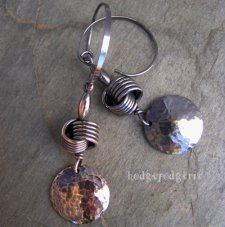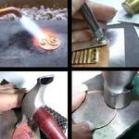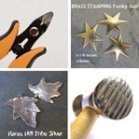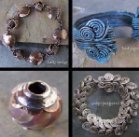▪ Liver-of-Sulfur Patina ▪

Some of the most frequently asked questions I get in classes and online are about oxidizing metal with Liver-of-Sulfur. Getting the patina process down just right is an art in itself and something you can perfect over time with much experimentation. To help you get consistent results, write down what you've done so you can duplicate it in the future. Here are some of my observations and answers to some of the more commonly asked questions. I hope it takes some of the mystery and fear out of using Liver-of-Sulfur.
What is a patina?
A patina is a film that develops on the surface of metal over a period of time. Due to exposure to open air and the natural process of oxidation, an aged metal such as copper and bronze tends to develop a patina. Ever notice the green color on copper roofs or weather vanes or the lovely rich dark brown color of bronze statues in the park? Those are patinas. The process by which a patina forms is called patination. Because it can naturally take from days to years to occur, in wire jewelry making we speed up the process so-to-speak and create the patina we wish our jewelry to have. There are many types of patinas, but today I'm discussing one of the more commonly used patinas, Liver-of-Sulfur.
Always remember safety first!!!! Please be sure to wear protective eye wear and gloves when handling chemicals or steel wool or whenever appropriate. Use chemicals only in well ventilated areas or outdoors.
What is Liver-of-Sulfur?
Liver-of-sulfur (LOS) is a very smelly, stinky :) sulfur product that is a mixture of potassium sulfides. They are commonly used to turn metals like copper and silver dark. It comes in the form of nuggets, liquid and more recently, a new gel. The nugget form has a long shelf life and is easy to use, providing you don't introduce moisture to it. However, with the introduction of the new gel form, I find it to be even more user-friendly and is the form I use in my classes. Plus, it has the advantage of not being affected by moisture.
You must store LOS in a cool dry place out of the sunlight. I have found that keeping it in the container it arrives in, then placing that in a zip lock-style bag and then that in a cookie jar etc. keeps it out of harm's way and the local air supply free of the nasty sulfur smell. It also keeps the items you don't want to oxidize safe from accidental exposure.
Use tweezers or a plastic spoon to retrieve a nugget from the container so that you don't contaminate the LOS with either wet fingers or the oil from your fingers. A tiny bit of moisture in the LOS nugget form will quickly ruin it. If it no longer smells...it's gone inert and is no good. The fumes from the liver-of-sulfur you're working on can oxidize the metal of the jewelry you're wearing, not just what's being dipped, so be sure to remove all jewelry from your working area.
Application Methods
The temperature of the LOS solution is very important in determining the finished results you'll get with the patina. A very hot solution of a pea-sized nugget dissolved in 1 cup of water will oxidize your copper dark brown and your silver dark grey.
Fine silver takes longer to oxidize than Sterling. In a lukewarm to cool solution, silver will stay yellowish to red for what seems like forever! Temperature is the key here. You'll know you've got it right when the silver immediately turns grey, not yellow.
By adding 1 teaspoon of ammonia to the solution, you'll get a very black patina. Too much ammonia, and you'll get a slightly reddish patina. I prefer the black look to the brownish color LOS creates by itself.
By changing the temperature of not just the solution but the pieces to be oxidized, you can create some lovely colors. The resulting yellows, reds, golds, purples, etc. can be very beautiful, but they are not a stable or permanent change. Left in the open air, over time copper continues to oxidize and turns brown like a penny. To preserve the patina, you must apply a protective coating. The only one I've found to be effective for a long time and durable is Permalac sealant. Permalac also prevents the metal from further oxidizing under the coating.
I've found that by tumbling my copper items first, then adding the patina, letting them completely air-dry after putting them in the LOS solution, and then re-tumbling, I get a very dark beautiful finish. After removing from the tumbler I use a Sunshine Polishing Cloth to buff, exposing the bright copper highlights on the raised parts of my design and leaving a very dark patina on the rest. The finished result is beautiful!
The copper earring pictured at the top right of the article shows the black oxidized metal after 2 hours in the tumbler. The earring on the left has been further finished with a polishing cloth. If you tumble for a longer time, then the tumbling action starts to remove the patina, creating a different look. I prefer the metal dark, but clean and shiny. Experiment to get the color you like best.
With silver, I've found it best to remove as much of the oxidation as I can using fine 0000 steel wool or a 3M pad while the item is still wet because once it dries, it requires a lot of elbow grease to remove. After buffing with the steel wool or 3M pad, rinse and let tumble for several hours. This gives you a bright silver finish with dark recessed areas.
To get a brushed antique finish, oxidize, tumble for 2-6 hours, then buff with 0000 steel wool. Rinse and you're done!
As to the LOS...if your solution is too cool, then the product will build up on the metal causing an icky coating that will chip off. It's not actually bonded to the metal. A hotter solution will help prevent that scaly build-up.
Contrary to some beliefs, you can oxidize items made with both silver and copper...the copper does not prevent the silver from oxidizing. However, the silver oxidizes more slowly than copper and by using a much hotter mixture you'll even out the oxidizing time. If your copper is getting black but the silver looks untouched or yellow, then your mixture is not hot enough. If you leave your jewelry in waiting for the silver to take, you'll get that yucky build-up of oxidation on the copper that flakes off. It's messy and gives a poor final product. Heating both metals before adding them to the solution will help to keep your solution hot.
Important Notes
Keep in mind that when putting a glass or gemstone item into a HOT liquid, you must first warm them up. Do this by holding under a spray of hot water from your faucet until the beads are warm or immerse in a bowl of warm water and gradually add hotter water. You may then put them into the hot LOS solution.
When the desired color is obtained, put the item into a solution of 1 teaspoon of baking soda to 1/2 cup water to stop further oxidation. Then rinse with clean water.
You can spot oxidize by using a small paint brush or cotton swab and apply the LOS only to the area you want it. Rinse and let it dry and then buff the entire piece with 000 Extra Fine steel wool. Then, use a polishing cloth. I prefer the Sunshine¨ brand. You may want to buff with steel wool or dip in nail polish remover (acetone) before you re-oxidize or add a lacquer coating in order to remove anything that may be on the surface. Try wrapping your polishing cloth around a pencil eraser and using that to buff the surface...it will help get into the lower areas.
I recommend that you wear protective gloves when you use LOS to prevent the chemical and SMELL from being absorbed into your hands. Also, the gloves will prevent the black messy stuff and the steel wool fibers from going into your skin. Also, use in a well ventilated area as breathing concentrated fumes is not a good idea.
The nugget form of Liver-of-sulfur is potentially sparkable and flammable (it's sulfur...as found in gunpowder), so don't smoke around it or use it around a flame. The stabilized LOS gel is neither flammable nor sparkable, making it an excellent choice for safety-minded individuals. I offer this product in my Etsy store.
Have fun experimenting!
Do you have other questions about Liver-of-Sulfur or other jewelry finishing techniques? Ask them in my Patinas and Protective Finishes Q & A page!
















